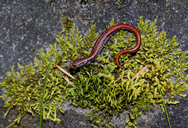|
Batrachoseps wrighti (Bishop, 1937)
Oregon Slender Salamander Subgenus: Plethopsis | family: Plethodontidae subfamily: Hemidactyliinae genus: Batrachoseps |
 © 2010 Mark V. Leppin (1 of 19) |
|
|
Batrachoseps wrighti (Bishop, 1937) R. Bruce Bury1 1. Historical versus Current Distribution. Oregon slender salamanders (Batrachoseps wrighti) only occur in western Oregon from the south side of the Columbia River Gorge southward in the Cascade Mountains to southern Lane County. Populations typically are restricted to (but not exclusively) the west slopes of the Cascades (Kirk, 1991; Kirk and Forbes, 1991). Animals are found from about 15 m elevation (in the Columbia Gorge) to 1,340 m (Nussbaum et al., 1983; Leonard et al., 1993; Petranka, 1998). 2. Historical versus Current Abundance. Declines have been associated with the clearcutting of ancient and mature forests (Nussbaum et al., 1983; Bury and Corn, 1988b). Oregon slender salamanders are considered by the State of Oregon to be a Sensitive Species of vulnerable status. Results of time-constrained searches (Gilbert and Allwine, 1991) showed that Oregon slender salamanders were second only to ensatinas in abundance in naturally regenerated stands: 1.26 salamander/site in old growth; 2.10 in mature; and 2.1 in young. Earlier, Bury and Corn (1998) found that Oregon slender salamanders were associated most closely with well-decayed pieces of coarse woody debris on forest floors, which is characteristic of old-growth and mature forests. 3. Life History Features. A. Breeding. Reproduction is terrestrial. i. Breeding migrations. Unknown and unlikely. ii. Breeding habitat. Unknown. As judged from females with spermatophores, courtship and breeding take place in April, May, and early June (Nussbaum et al., 1983). B. Eggs. i. Egg deposition sites. Likely to be underground or deep within large, decaying logs. Ovipositing occurs from April–June. ii. Clutch size. Average ovarian egg count is 6.3 (range = 3–11, n = 38; Nussbaum et al., 1983). Tanner (1953) found a clutch with eight eggs. Jockusch (1997b) and Jockusch and Mahoney (1997) report a mean of 5.1 ± 2.0 (s.d.) eggs with a maximum of 10 eggs for 22 clutches. Eggs are about 4 mm in diameter. C. Direct Development. i. Brood sites. Same as egg deposition sites. Incubation time is about 4.5 mo at 12 ˚C (Stebbins, 1949a). Jockusch (1997b) and Jockusch and Mahoney (1997) report a mean of 126 d ± 8 (s.d.) to hatching at 13 ˚C for 28 clutches. ii. Parental care. Tanner (1953) found a female attending eight eggs. D. Juvenile Habitat. Hatchlings measure 13–14 mm SVL (19–20 mm TL; Stebbins, 1949a; see also Petranka, 1998). Juvenile habitat is unknown, but is likely similar to adult habitat. E. Adult Habitat. Adults are most often found within large, well-decayed logs and stumps in old growth and mature forests. Bury and Corn (1988b) report that they occur more often than expected in older decay classes of coarse woody debris, and most (62%) were in logs, under bask (26%), or on/under logs (7%). They have also been found on lava flows (Nussbaum et al., 1983; Petranka, 1998). They occasionally are found under large rocks that are moss covered and in stabilized talus (Leonard et al., 1993). Animals are active after snowmelt in the spring, but at other times of the year inhabit underground burrows or sites deep within large logs. F. Home Range Size. Unknown. G. Territories. Unknown. Individuals often are found clumped together, with two or more under the same object (Leonard et al., 1993). This suggests little territoriality. However, there are no detailed ecological studies on this species. H. Aestivation/Avoiding Dessication. Aestivation is unknown; animals likely avoid dessicating condition by seeking shelter under cover objects or in burrows. I. Seasonal Migrations. Unknown. J. Torpor (Hibernation). Unlikely. K. Interspecific Associations/Exclusions. Not documented. L. Age/Size at Reproductive Maturity. Males mature at 33 mm SVL, females at 35. Adults typically measure 85–120 mm TL, with females about 12% greater in length (SVL; Petranka, 1998). M. Longevity. Unknown. N. Feeding Behavior. Prey include small invertebrates such as pseudoscorpions, centipedes, mites, spiders, snails, annelids, and insects such as dipterans and collembolans. O. Predators. Undocumented, but likely to include reptiles, birds, and small mammals. P. Anti-Predator Mechanisms. Oregon slender salamanders are secretive, and in the presence of potential predators they remain immobil or coil (Brodie, 1977). They may rapidly uncoil and flip away (Stebbins and Lowe, 1949). Q. Diseases. Unknown. R. Parasites. Unknown. 4. Conservation. Oregon slender salamanders are listed as Protected by the State of Oregon (Levell, 1997), which means that a permit is required to possess or collect these animals. 1R. Bruce Bury Literature references for Amphibian Declines: The Conservation Status of United States Species, edited by Michael Lannoo, are here. Feedback or comments about this page.
Citation: AmphibiaWeb. 2024. <https://amphibiaweb.org> University of California, Berkeley, CA, USA. Accessed 19 Apr 2024. AmphibiaWeb's policy on data use. |




 Raffaëlli Account
Raffaëlli Account Map of Life
Map of Life